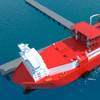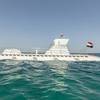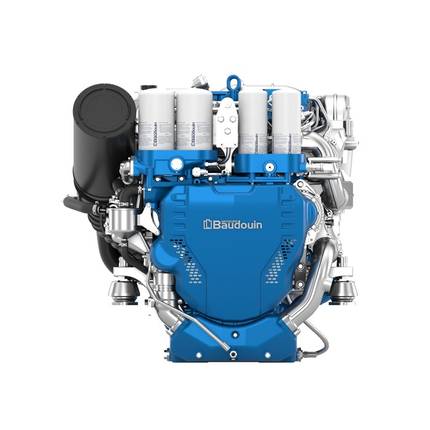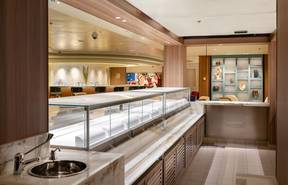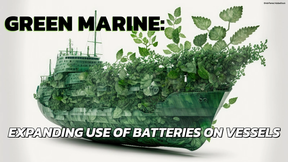OPINION: Hold the Bricks, Start the Discussion on the Future of Domestic Shipbuilding
With your first steps as a cadet onto the Maritime Academy campus, your first union dues payment or first line thrown ashore from the tug, you are lectured on the importance of the “Jones Act”. A constant reminder throughout a US Seafarer’s career of commitment, loyalty and support for the legislation. All in the name of National Security, US Job protection and the advancement of the US Flag Merchant Marine. It is a massive and expensive lobbying effort witnessed throughout generations at sea. The effort has been historically successful. That said, there are times when history does not repeat itself.
Those of us who have worked a half century in the industry remember the Boysie Bollinger speeches about the “three-legged stool” describing the Merchant Marine Act of 1920; American-Owned, American-Manned and American-Built. Others stepped up on the soapbox at conference agendas, industry events maritime gatherings and the occasional media report to comment on court cases and decisions that involved an attempt to abolish or circumvent the law. It has been a never-ending debate.
As a company with decades of experience building in the US domestic market, we have a list of accomplishments containing many “firsts” on both coasts, the US Gulf and the Great lakes. Top ten “best of build” awarded projects, military support to MarAd and MSC, the American Phoenix, resurrected from bankruptcy ashes, the first LNG bunker barge to support the move to dual fuel and a long 10 years of Hybrid and EV construction in an attempt to support the Marine Highway program.
We are “Jones Act” owners, operators and builders.
We make the statement above simply because the opinions of this article are ours and ours alone; an effort to open an important dialogue.
We believe we have earned the right to raise the opinions we are about to discuss because of that past experience. When cries of completely abolishing the legislation have been raised, we have remained supportive, as we do not believe that is the answer. That said, we believe it is time to develop a round table and look to modify the Act to keep pace with global technology and geopolitical events.
The US-Build Requirement & Bluewater Tonnage
That modification would include a time table for removing the US build requirement for commercial “Bluewater” tonnage both in domestic operation and global operation without restriction. Certain current events have made that discussion relevant.
In March of this year, the maritime media announced the addition of a 30-year-old, foreign built LNG cargo vessel, “reflagged U.S.” and entering the Puerto Rico trade. The vessel will load US LNG and discharge the cargo under a multi-year contract with Naturgy to the Puerto Rico energy system at Penuelas. The vessel operates under a “Jones Act“ loophole provided in the Coast Guard Authorization Act of 1996 allowing the use of foreign built LNG and LPG vessels in the Puerto Rican trade. The tonnage selected must be older than the language passed in the Act. Only two other foreign vessels operated under the “Jones Act” – the National Glory and the Coastal Trader – receiving reflag approval and coastwise documents. There are those in the industry that hope no other vessels of this age are available and other trade partners that will want an explanation of why New England and others exempted.
With that specific approval, one leg of the “three-legged stool” has been removed after 29 years. A first step in the change we are recommending.
Several informational media articles and YouTube social media posts have been published reporting the event. Historically a “Jones Act” announcement would have either received standing applause OR a brick through the front window.
As of this opinion, there has been no response from US Shipbuilders, the Industry lobbying groups or think tanks from either side of the table. The Waterways Journal on the week of the announcement had no mention of the activity and several industry comments wondered why the shipbuilding groups had missed a similar report weeks before in other trade news. The lack of comment is the simple fact that there is no customer base for commercial Bluewater tonnage at recent cost levels.
There are more than several roads to take with this announcement: One is the road less traveled.
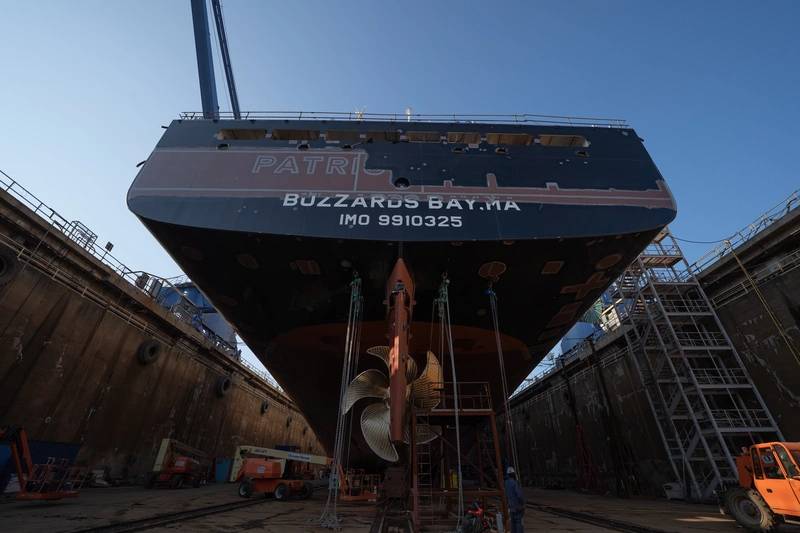 The government has invested roughly $2 billion dollars in tax payers’ money to build five new state academy training ships to educate future seafarers. Those vessels replaced aged and antiquated steam turbine vessels.
The government has invested roughly $2 billion dollars in tax payers’ money to build five new state academy training ships to educate future seafarers. Those vessels replaced aged and antiquated steam turbine vessels.
Photos courtesy Philly Shipyard [now Hanwha Phyilly Shipyard]
We are huge supporters of LNG for infrastructure energy and as a transition fuel for ship propulsion. The US Jones Act fleet embraced LNG as dual fuel technology long before IMO “emissions” was a major discussion in global shipping. That is the standing applause.
The cost analysis of moving LNG from Trinidad on foreign tonnage, container supply shipped US and the purchase of US LNG with this decision would most likely favor this reflag. The energy source is good for the Island, supports US LNG and the fact that the political community and shippers constantly attacking the costs associated with the “Jones Act” – have collected a “win.”
The vessel is 30 years old and the propulsion is steam boiler fueled by Boil Off Gas. There have been major upgrades to LNG construction and technology in the foreign yards and markets. Most, if not all have moved away from this propulsion method as it is inefficient and methane positive in emissions. None of the cargo or propulsion upgrades in LNG foreign construction and emission reductions are employed here.
That said, we do not view the transportation road taken as being a successful step forward for at this moment regardless if the law allows it. The short term “reflag” has the ability to delay a shipbuilding and manning rebirth now discussed from the White House to the tip of a welder’s stinger in the shipyards to a modification of the U.S. build requirement.
The government has invested roughly $2 billion dollars in tax payers’ money to build five new state academy training ships to educate future seafarers. Those vessels replaced aged and antiquated steam turbine vessels.
The Jones Act lobby effort has historically advised that foreign built tonnage is substandard and inferior. Our South Korean building relationships have firmly confirmed that statement is far from the truth and recent announcements in US shipyards being purchased by foreign entities to build both Navy and commercial tonnage seems to indicate our opinion is correct. We have not taken an opportunity to provide cutting edge technology to bring the next generation of maritime labor back to the industry. We have taken a step back to the future and the current state of our shipbuilding capacity will take decades to meet global competitive goals.
Trump 2.0 & the Maritime Industry
The new Administration has announced a sweeping reform of the nation’s shipbuilding and maritime sectors. In the President’s statement; “We used to make so many ships. We don’t make them anymore much, but we’re going to make them very fast, very soon. It will have a huge impact.”
The recent “SHIP ACT” legislation announced the construction of 250 ships and a promise to compete with China as we build new shipyard capacity. The ship types were not identified and that said, you can bet LNG vessels will make the list if it is ever developed. We have no LNG tonnage under the flag to support the export of the gas and we are decades away from announcing a delivery from a US shipyard. It is only the US build requirement of the “Jones Act” legislation that blocks that technology from reaching domestic operation and distributing US LNG to the East Coast and other states. Beyond assuming LNG will make the “250 list” there are other Bluewater ship “types” that are facing the same issue. Product tankers, chemical tankers, container feeders and government dual use military support to name a few.
Bluewater tonnage, U.S. built at the current price of construction and delivery period, has no customers.
The annual Shipbuilders Council of America introduced a panel this year of US ship operators to discuss the domestic market. The general consensus was a movement to life extension and extended repairs of existing tonnage. The decision process simply made as US new construction has reached cost levels that cannot support a profitable private business model. If we can reach a decision to discuss and modifying the Act, you may find out that life extension proposals are a solid decision and capable of taking us through the transition period to the modification introducing foreign newbuild approval. This is the most efficient and cost-productive program to deliver new bottoms and technology employing American seafarers.
Beyond the US build cost, we have lost the capacity of majority Tier I shipyards to projected Navy work needed to address current geopolitical events and National Security. National Steel & Shipbuilding has removed themselves from commercial shipbuilding. Do not be surprised when Hanwha Philadelphia announces all of the graving docks are booked for Navy construction.
Watch for reports from other abandoned shipyard locations with new investment to attract a Navy budget reaching $40 billion a year until 2054.
Truth is when we are now called to build a Jones Act MR, Containership or LNG vessel the response is “there is nowhere to build it”. Matson reported delaying the Aloha Class container project until 2027/2028 and the delays and cost overruns of the training ship program have been reported in the media for months.
With all the fanfare of Hanwha buying into U.S ship construction, it advised a $4 million dollar price increase on top of a $330 million price tag for each Aloha class vessel. There is no commercial shipbuilding customer base at these price levels to create a series production, option contracts or program to deliver Bluewater tonnage.
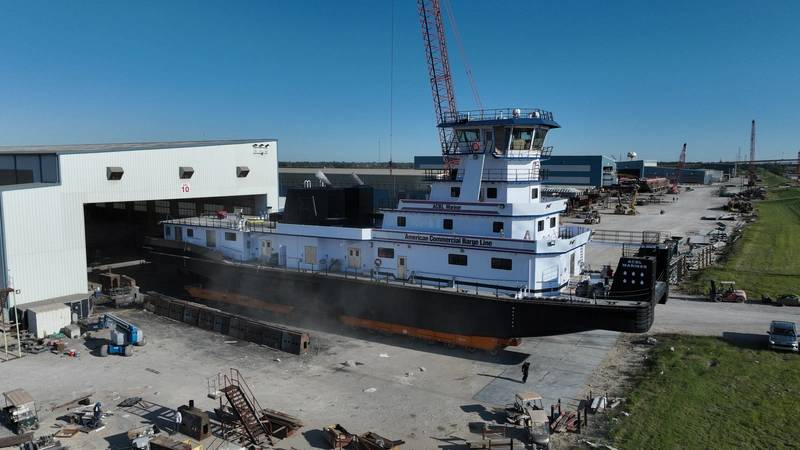 The “Act” must support and protect the smaller “mom & pop” second tier shipyards who have always been competitive and have always kept pace with technology. Tugs, ATBs, Barges, Ferries, PSV, OSV – Tier IV, Hybrid, pure EV, LNG bunker, SOV and CTV. This is the backbone of the U.S. commercial shipbuilding future and their space must be protected.
The “Act” must support and protect the smaller “mom & pop” second tier shipyards who have always been competitive and have always kept pace with technology. Tugs, ATBs, Barges, Ferries, PSV, OSV – Tier IV, Hybrid, pure EV, LNG bunker, SOV and CTV. This is the backbone of the U.S. commercial shipbuilding future and their space must be protected.
Photo courtesy ACBL
With that, bring the remaining yards with a commercial standard into US Navy and US Coast Guard work. Fix the historical contracting and logistics problems and make the Navy a good reliable customer. Put the Tier I commercial shipyards to work, build the labor force while commercial operators look at Bluewater construction in Europe, South Korea and Japan to reinvent our domestic markets.Now look at the most important part and members of the round table.
The “Act” must support and protect the smaller “mom & pop” second tier shipyards who have always been competitive and have always kept pace with technology. Tugs, ATBs, Barges, Ferries, PSV, OSV – Tier IV, Hybrid, pure EV, LNG bunker, SOV and CTV. This is the backbone of the US commercial shipbuilding future and their space must be protected.
Beyond new construction, the level of discussion must also address ship repair. In no uncertain terms, our capability to repair tonnage entering the trades over the next 20 years with this proposed modification to the legislation will not be your father’s shipyard. Watch as 3D printing, digital twin, AI, and robotics enters the mix. I am educated by our recent Maritime Academy graduates and Naval Architects every day on the technological advances being introduced. No different than the Navy recognizing the deficiency of their repair programs, we must confirm that the new commercial tonnage is supported by a vibrant manufacturing and repair base. Make it a requirement.
This is a discussion that is not an immediate fix, but a planned schedule replacing assets of existing tonnage built at US costs and supporting the companies that made that investment under the law. I will use the Orca Class RoRos and the Totem Ocean Express operation in Alaska and Tacoma as an example. If you are not aware of the actual operation, it is one of the most efficient examples of US Maritime operation. That said, the two vessels serving the operation are near 20 years of age. An example of life extension analysis when considering the replacement cost of these vessels, in a US yard. A cost that would easily exceed $400 million per vessel. Where the Pentagon has recently reported that it will look to purchase five foreign ships a year to replace and rebuild aged MSC, MARAD and Transcom support or ROS tonnage, why not purchase American assets from the domestic companies at a price that recognizes the support we discussed in the opening paragraph.
Introduce new foreign built tonnage under US flag one trade route at a time, with minimal business disruption and loss of jobs as the transition takes place.
At this point, if you have finished reading this OPED, thank you for the opportunity to provide our opinion. I have put the plywood up over the windows. Save the bricks to build a new industry future.
The views expressed in this article are those of the author(s) and do not necessarily reflect the official policy or position of any affiliated organization, agency, or the publisher.





